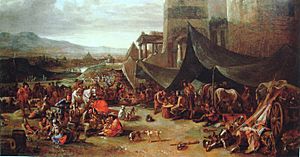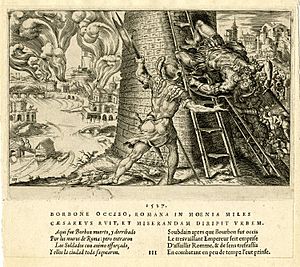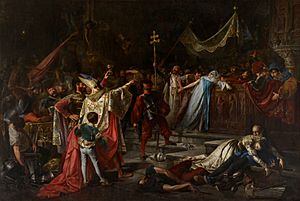Sack of Rome (1527) facts for kids
Quick facts for kids Sack of Rome |
|||||
|---|---|---|---|---|---|
| Part of the War of the League of Cognac | |||||
 The sack of Rome in 1527, by Johannes Lingelbach, 17th century (private collection) |
|||||
|
|||||
| Belligerents | |||||
|
|||||
| Commanders and leaders | |||||
|
|||||
| Strength | |||||
|
20,000+ (mutinous)
|
||||
| Casualties and losses | |||||
| 1,000 militiamen killed 458 Swiss Guards killed |
unknown | ||||
| 45,000 civilians dead, wounded, or exiled | |||||
The Sack of Rome was a terrible event that happened on May 6, 1527. The city of Rome, which was then part of the Papal States, was attacked and taken over by soldiers. These soldiers were part of the army of Charles V, Holy Roman Emperor, but they had rebelled because they hadn't been paid.
Even though Emperor Charles V didn't order the attack, his unpaid army stormed the city. This army included 14,000 German soldiers, 6,000 Spanish soldiers, and some Italian fighters. They looted, killed, and held people for ransom without anyone stopping them. Pope Clement VII had to hide in Castel Sant'Angelo after his special guards, the Pontifical Swiss Guard, were almost completely wiped out. He stayed there until a large sum of money was paid to the attackers.
The city of Rome suffered greatly. Its population dropped from 55,000 people to just 10,000. Many people died from the violence, hunger, and a disease outbreak. The Sack of Rome also made the disagreements between Catholics and Protestants much worse.
What Led to the Attack on Rome?
Pope Clement VII's Concerns
Pope Clement VII was worried about the growing power of Charles V, Holy Roman Emperor. The Pope thought Charles V wanted to control the Catholic Church and all of Italy. To stop this, Pope Clement VII joined forces with Charles V's enemy, King Francis I of France. This alliance was called the League of Cognac.
The Emperor's Unpaid Army
The army of the Holy Roman Emperor defeated the French army in Italy. But there wasn't enough money to pay the soldiers. About 34,000 Imperial troops rebelled because they were unpaid. They forced their leader, Duke Charles III, Duke of Bourbon, to march them towards Rome. Rome was an easy target for them to rob because of the political problems at the time.
The Army's Makeup
The army included about 6,000 Spanish soldiers led by Duke Charles. There were also 14,000 German soldiers called Landsknechte, led by Georg von Frundsberg. Some Italian fighters and powerful cardinals like Pompeo Colonna and Luigi Gonzaga also joined. Even though Martin Luther was against attacking Rome, some of his followers saw the Pope's city as a target for religious reasons. Many bandits and soldiers who had left the League's army also joined the march.
March to Rome
Duke Charles left Arezzo on April 20, 1527. He took advantage of the confusion among the Venetians and their allies. This confusion happened after a revolt in Florence against Pope Clement VII's family, the Medici. His soldiers, who were not well-controlled, robbed Acquapendente and San Lorenzo alle Grotte. Then they took over Viterbo and Ronciglione. They reached the walls of Rome on May 5.
The Attack on Rome

Rome's Defenses
The Imperial army had 14,000 German soldiers, 6,000 Spanish soldiers, and an unknown number of Italian fighters. Rome's defenders were much fewer. There were only 5,000 local soldiers led by Renzo da Ceri and 189 Swiss Guards. Rome had strong walls and good cannons, which the Imperial army did not have. Duke Charles needed to capture the city quickly. He wanted to avoid being trapped between the city and the League's army.
The Assault and Duke Charles's Death
On May 6, the Imperial army attacked the walls near the Gianicolo and Vatican Hills. Duke Charles was shot and badly wounded during the attack. Some say Benvenuto Cellini shot him. Duke Charles was wearing a white cloak to help his troops see him, but it also made him an easy target for his enemies.
His death meant the army lost its last respected leader. This caused the soldiers to lose all control. They easily captured the walls of Rome that same day. Philibert of Châlon took command, but he wasn't as popular or feared. This meant he had very little power over the soldiers.
The Stand of the Swiss Guard
The Swiss Guard made a brave last stand in the Teutonic Cemetery inside the Vatican. Their captain, Kaspar Röist, was wounded. He tried to hide in his house but was killed by Spanish soldiers. The Swiss Guards fought fiercely, but they were greatly outnumbered and almost all of them died.
A few survivors, along with some refugees, fell back to the steps of St. Peter's Basilica. Those who went towards the Basilica were killed. Only 42 Swiss Guards survived. This small group, led by Hercules Goldli, managed to hold off the attacking soldiers. They protected the Pope's group as it escaped through the Passetto di Borgo. This was a secret raised passage connecting the Vatican City to Castel Sant'Angelo.

The Pillage of Rome
After about 1,000 defenders were killed, the looting began. Churches, monasteries, and the homes of religious leaders were robbed and destroyed. Even cardinals who supported the Emperor had to pay money to save their properties. On May 8, Cardinal Pompeo Colonna, an enemy of Pope Clement VII, entered the city. He was followed by farmers from his lands. They had come to get revenge for attacks they had suffered from the Pope's armies. Cardinal Colonna was saddened by the terrible state of the city. He offered shelter to some Roman citizens in his palace.
The Vatican Library was saved because Philibert set up his headquarters there. After three days of destruction, Philibert ordered the looting to stop, but few soldiers listened. Meanwhile, Pope Clement remained a prisoner in Castel Sant'Angelo.
Pope Clement's Surrender
On June 1, Francesco Maria I della Rovere and Michele Antonio of Saluzzo arrived with troops north of the city. But they were too careful and missed a chance to easily defeat the uncontrolled Imperial troops. On June 6, Pope Clement VII gave up. He agreed to pay a ransom of 400,000 ducati to save his life. He also had to give up control of some cities to the Holy Roman Empire. While this was happening, Venice took advantage of the situation to capture some other cities.
What Happened After the Sack?

End of the Renaissance Era
The Sack of Rome is often seen as the end of the Italian High Renaissance. This event had a huge impact on Europe, Italy, and Christianity. It created long-lasting changes in European culture and politics.
Before the Sack, Pope Clement VII was against Emperor Charles V's plans. He believed Charles wanted to control Italy and the Church. After the Sack, the Pope no longer had the military or money to resist. To avoid more fighting, Clement decided to cooperate with Charles. Charles then gained more control over the Church and Italy.
Impact on Rome and Italy
The Sack had major effects on Italian society and culture, especially in Rome. Pope Clement's war would be the last fight for Italian independence until the 1800s. Rome, which had been a center for art and learning, lost many people and its economy collapsed. Artists and thinkers left the city. The population of Rome dropped from over 55,000 before the attack to just 10,000 afterward. It's thought that between 6,000 and 12,000 people were killed.
Many Imperial soldiers also died later, mostly from diseases. The looting finally stopped in February 1528, eight months after the attack. This was because the city ran out of food, there was no one left to ransom, and a plague appeared. Rome did not get back its population until around 1560.
Changes in the Catholic Church
The Sack also shifted power away from the Pope and towards the Emperor. Emperor Charles was embarrassed that his troops had imprisoned the Pope. However, he had sent troops to Italy to gain control over Clement. Charles eventually made peace with the Pope through the Treaty of Barcelona (1529).
After this, Charles began to shape the Church as he wanted. Pope Clement never directly opposed the Emperor again. He agreed to Charles's demands, like naming cardinals chosen by Charles. He also crowned Charles as Holy Roman Emperor in 1530. Clement also refused to end the marriage of Charles's aunt, Catherine of Aragon, to King Henry VIII of England. This decision helped lead to the English Reformation.
These actions changed the Catholic Church. It moved away from the free thinking of the Renaissance Popes. Instead, it moved towards the strict religious rules seen in the Counterreformation. After Clement died in 1534, the Inquisition became more common. The focus on humanism, which was popular in the Renaissance, was seen as against Church teachings.
Division Between Catholics and Protestants
The Sack also helped make the split between Catholics and Protestants permanent. Before the Sack, Charles and Clement disagreed on how to deal with Martin Luther and the Protestant Reformation. Charles wanted a Church Council to solve the problem. Clement was against this, fearing that kings would control Church policy.
After the Sack, Clement agreed to Charles's wishes. He agreed to call a Church Council and chose Trent, Italy as its location. However, he did not start the Council of Trent during his lifetime. He feared it would be dangerous. In 1545, eleven years after Clement's death, his successor Pope Paul III started the Council of Trent. It did reform some corruption in the Catholic Church. But by then, it was too late for Catholics and Protestants to truly reunite.
Swiss Guard Tradition
To remember the bravery of the Swiss Guard in defending Pope Clement VII during the Sack of Rome, new recruits to the Swiss Guard take their oath on May 6 every year.
See also
 In Spanish: Saco de Roma para niños
In Spanish: Saco de Roma para niños

